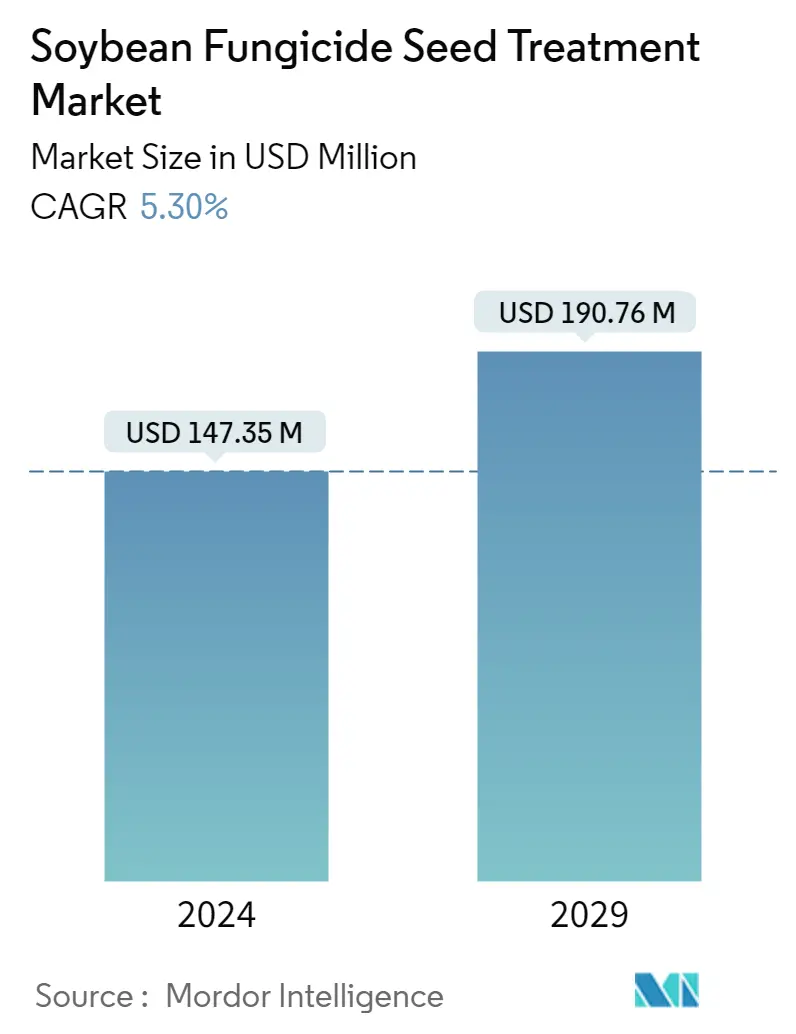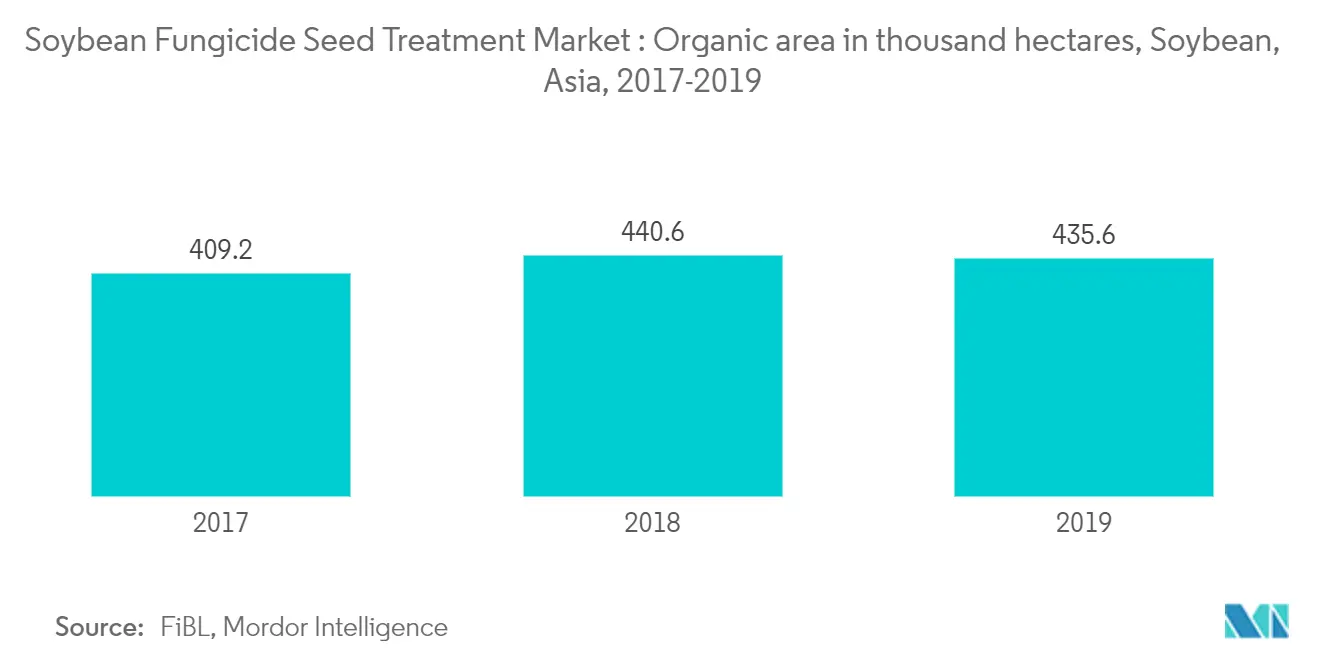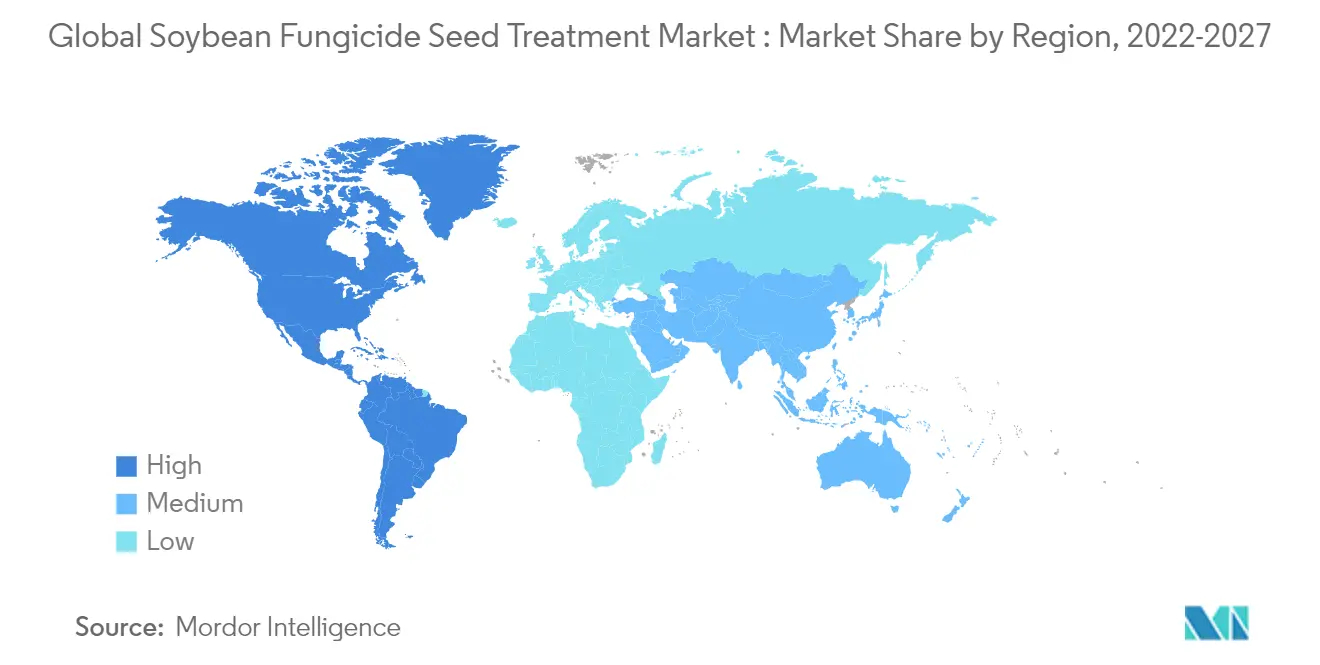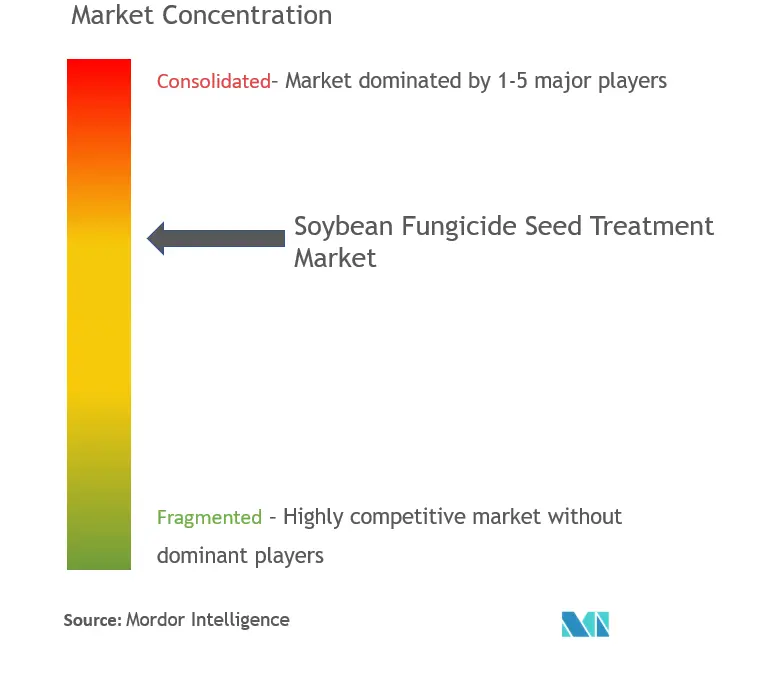Soybean Fungicide Seed Treatment Market Size

| Study Period | 2019 - 2029 |
| Market Size (2024) | USD 147.35 Million |
| Market Size (2029) | USD 190.76 Million |
| CAGR (2024 - 2029) | 5.30 % |
| Fastest Growing Market | South America |
| Largest Market | South America |
Major Players
*Disclaimer: Major Players sorted in no particular order |
Soybean Fungicide Seed Treatment Market Analysis
The Soybean Fungicide Seed Treatment Market size is estimated at USD 147.35 million in 2024, and is expected to reach USD 190.76 million by 2029, growing at a CAGR of 5.30% during the forecast period (2024-2029).
The market studied has been partially affected due to the COVID-19 pandemic, due to the logistics and supply constraints observed across the world. The restriction in movements of shipments and high air, sea, or land freight was observed to be a major factor disrupting the businesses, including seed treatment fungicides.
In the long run, increasing food demand, the rising innovation in crop protection technology, the increasing demand for biological seed treatments, and increasing government support would drive the global market of soybean fungicide seed treatment. Rising demand for biological seed treatment products has been observed in recent years. Recognizing this demand, the players are actively launching new biological seed treatment products in the market. In 2021, a new biological seed treatment, CeraMax, was registered under EPA to protect soybean crops from sudden death syndrome(SDS) produced by Ceradis BV.
Furthermore, the rising demand for higher yield due to the rapid increase in the consumption of crops has increased the demand for the seed treatment market in north America and South America. However, as as soybean plants grown in fields are highly prone to phytophthora root and stem rot and increasing awareness about the quality and safety of the seeds to protect from disease infestation, seed treatment practice in Asia-Pacific is also advancing at a faster rate.
Thus, the importance of treated seed, coupled with the strategies adopted by players, such as expanding market and innovating new technologies, is bound to lead to the growth of the soybean fungicide seed treatment market.
Soybean Fungicide Seed Treatment Market Trends
This section covers the major market trends shaping the Soybean Fungicide Seed Treatment Market according to our research experts:
Rapidating Demand for Biological Seed Treatment
The rising environmental concerns, especially in many developed regions, the demand for biological seed treatment is rising, fueling the market's growth during the forecast period. Hence, more chemical companies are offering biological seed treatments to capture the market demand. Major players are selling soybean seeds treated with a combination of biologicals and chemicals to the growers in the United States. For instance, several pioneer soybean seed products sold in North America are treated with biological seed treatments to improve stand, plant vigor, and yield.
Biological seed treatments use active ingredients, including living microbes, fermentation products, plant extracts, phytohormones, and even hard chemistry, to have a favorable impact on plants. Owing to their ability to optimize plant growth, minimize stress, and boost overall yield by empowering the genetic potential of the plant, biological seed treatments are witnessing increasing demand.
Recognizing the potential, more companies are entering the biological seed treatment market space. In 2021, the FMC corporation entered into distribution agreements with Syngenta Crop Protection to commercialize Draco, a biological seed treatment for corn and soybean in Canada. The product has a unique mode of action that combines bacillus licheniformis and bacillus subtilis to offer Canadian farmers protection against yield-robbing root pests, such as rhizoctonia and nematodes.

South America Dominates the Market
In 2020, Brazil was the top producer of soybean in the world acoording to the Food and Agriculture Organization(FAO). This, coupled with increasing fungal diseases, leads to the hiher application of seed treatment fungicide and is anticipated to be increase in the coming years. Soybean rust, caused by Phakopsora pachyrhizi, is the major fungal infestation in the country. However, soybean is majorly affected by insects, compared to other pests.
Increasing farm size and decreasing crop rotation, coupled with rising awareness on Bio agribusiness are some of the factors contributing to the continuing strength of Brazil's seed sector which leads to the rapid adoption of high-value seeds. With Brazilian crop production narrowly focused on soybeans along with maize, virtually every seed gets treated, often more than once before it is planted.
In recent years, increased adoption of advanced technologies and management practices in agriculture can be witnessed, including biological seed treatments that significantly improve implantation and reduce costs. In this regard, in 2018, Syngenta launched Vibrance Maxx, a soybean seed treatment in the Argentine market. Therefore, being a major producer and exporter for soybeans, increased adoption of innovating technologies, coupled with the active participation of players, the soybean fungicide seed treatment market is anticipated to grow during the forecast period.

Soybean Fungicide Seed Treatment Industry Overview
The global market for soybean fungicide seed treatment is highly consolidated, with major players such as Syngenta International AG, BASF SE, Bayer Crop Science AG, Corteva Agriscience, UPL, and Kureha Corporation, among others. Syngenta International AG occupies the largest market share, followed by BASF SE and Bayer Crop Science AG.
Soybean Fungicide Seed Treatment Market Leaders
-
BASF SE
-
Syngent International AG
-
Bayer CropScience AG
-
Corteva Agriscience
-
UPL
*Disclaimer: Major Players sorted in no particular order

Soybean Fungicide Seed Treatment Market News
Syngenta International AG is involved in major strategies including innovation and expansion. For instance, in March 2021, Syngenta introduced VAYANTIS fungicide seed treatment; the product contains picarbutrazox to protect corn and soybean seedlings from acute diseases such as Pythium.
Expansion is one of the major strategies adopted by key players to strengthen their position and gain a broader consumer reach in the market. For instance, in 2020, BASF expanded its Sparks, GA, facility. The company invested approximately USD 70 million in capital improvements to produce seed treatment formulations.
Further, in 2020, BioWorks launched a new, easier to use the formulation of its RootShield PLUS+ WP biological fungicide in Canada. This biological fungicide is for use in soil applications (drench, in soil furrow, and potting soil), and seed treatments for many crops including soybean.
Soybean Fungicide Seed Treatment Market Report - Table of Contents
1. INTRODUCTION
- 1.1 Study Assumptions and Market Definition
- 1.2 Scope of the Study
2. RESEARCH METHODOLOGY
3. EXECUTIVE SUMMARY
4. MARKET DYNAMICS
- 4.1 Market Overview
- 4.2 Market Drivers
- 4.3 Market Restraints
-
4.4 Porter's Five Force Analysis
- 4.4.1 Bargaining Power of Suppliers
- 4.4.2 Bargaining Power of Buyers
- 4.4.3 Threat of New Entrants
- 4.4.4 Threat of Substitutes
- 4.4.5 Degree of Competition
5. MARKET SEGMENTATION
-
5.1 Type
- 5.1.1 Chemical
- 5.1.2 Non-Chemical/Biological
-
5.2 Geography
- 5.2.1 North America
- 5.2.1.1 United States
- 5.2.1.2 Canada
- 5.2.1.3 Mexico
- 5.2.1.4 Rest of North America
- 5.2.2 Europe
- 5.2.2.1 Germany
- 5.2.2.2 United Kingdom
- 5.2.2.3 France
- 5.2.2.4 Spain
- 5.2.2.5 Italy
- 5.2.2.6 Russia
- 5.2.2.7 Rest of Europe
- 5.2.3 Asia Pacific
- 5.2.3.1 China
- 5.2.3.2 Japan
- 5.2.3.3 India
- 5.2.3.4 Thailand
- 5.2.3.5 Vietnam
- 5.2.3.6 Australia
- 5.2.3.7 Rest of Asia-Pacific
- 5.2.4 South America
- 5.2.4.1 Brazil
- 5.2.4.2 Argentina
- 5.2.4.3 Rest of South America
- 5.2.5 Africa
- 5.2.5.1 South Africa
- 5.2.5.2 Rest of Africa
6. COMPETITIVE LANDSCAPE
- 6.1 Most Adopted Strategies
- 6.2 Market Share Analysis
-
6.3 Company Profiles
- 6.3.1 Kureha Corporation
- 6.3.2 Syngenta International AG
- 6.3.3 Bayer CropScience AG
- 6.3.4 BASF SE
- 6.3.5 Bioworks Inc.
- 6.3.6 UPL
- 6.3.7 Corteva Agriscience
- 6.3.8 Nufarm Ltd
- 6.3.9 Sumitomo Chemical Co. Ltd
- 6.3.10 Andermatt Group AG
- *List Not Exhaustive
7. MARKET OPPORTUNITIES AND FUTURE TRENDS
8. ASSESSMENT OF IMPACT OF COVID-19 ON THE MARKET
** Subject To AvailablitySoybean Fungicide Seed Treatment Industry Segmentation
According to the International Seed Federation, seed treatment products are biological, physical, and chemical agents and techniques applied to seeds to protect and improve the establishment of healthy crops. The report presents an in-depth analysis of the market share, size, and trends of the market of soybean fungicide seed treatment on a global scale.
The global soybean fungicide seed treatment market is segmented By Application (Chemicals and Non-Chemical/Biological). The market is also segmented By Geography into (North America, Europe, Asia-Pacific, South America, and Africa). The report offers market estimation and forecast in terms of value in USD thousand for the soybean fungicide seed treatment market.
| Type | Chemical | |
| Non-Chemical/Biological | ||
| Geography | North America | United States |
| Canada | ||
| Mexico | ||
| Rest of North America | ||
| Geography | Europe | Germany |
| United Kingdom | ||
| France | ||
| Spain | ||
| Italy | ||
| Russia | ||
| Rest of Europe | ||
| Geography | Asia Pacific | China |
| Japan | ||
| India | ||
| Thailand | ||
| Vietnam | ||
| Australia | ||
| Rest of Asia-Pacific | ||
| Geography | South America | Brazil |
| Argentina | ||
| Rest of South America | ||
| Geography | Africa | South Africa |
| Rest of Africa |
Soybean Fungicide Seed Treatment Market Research FAQs
How big is the Soybean Fungicide Seed Treatment Market?
The Soybean Fungicide Seed Treatment Market size is expected to reach USD 147.35 million in 2024 and grow at a CAGR of 5.30% to reach USD 190.76 million by 2029.
What is the current Soybean Fungicide Seed Treatment Market size?
In 2024, the Soybean Fungicide Seed Treatment Market size is expected to reach USD 147.35 million.
Who are the key players in Soybean Fungicide Seed Treatment Market?
BASF SE, Syngent International AG, Bayer CropScience AG, Corteva Agriscience and UPL are the major companies operating in the Soybean Fungicide Seed Treatment Market.
Which is the fastest growing region in Soybean Fungicide Seed Treatment Market?
South America is estimated to grow at the highest CAGR over the forecast period (2024-2029).
Which region has the biggest share in Soybean Fungicide Seed Treatment Market?
In 2024, the South America accounts for the largest market share in Soybean Fungicide Seed Treatment Market.
What years does this Soybean Fungicide Seed Treatment Market cover, and what was the market size in 2023?
In 2023, the Soybean Fungicide Seed Treatment Market size was estimated at USD 139.93 million. The report covers the Soybean Fungicide Seed Treatment Market historical market size for years: 2019, 2020, 2021, 2022 and 2023. The report also forecasts the Soybean Fungicide Seed Treatment Market size for years: 2024, 2025, 2026, 2027, 2028 and 2029.
Soybean Fungicide Seed Treatment Industry Report
Statistics for the 2024 Soybean Fungicide Seed Treatment market share, size and revenue growth rate, created by Mordor Intelligence™ Industry Reports. Soybean Fungicide Seed Treatment analysis includes a market forecast outlook to 2029 and historical overview. Get a sample of this industry analysis as a free report PDF download.



